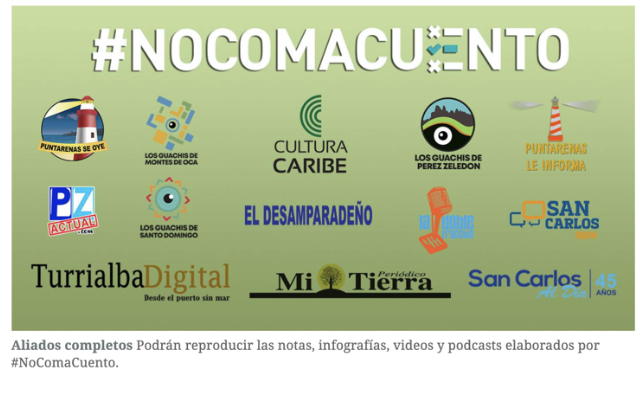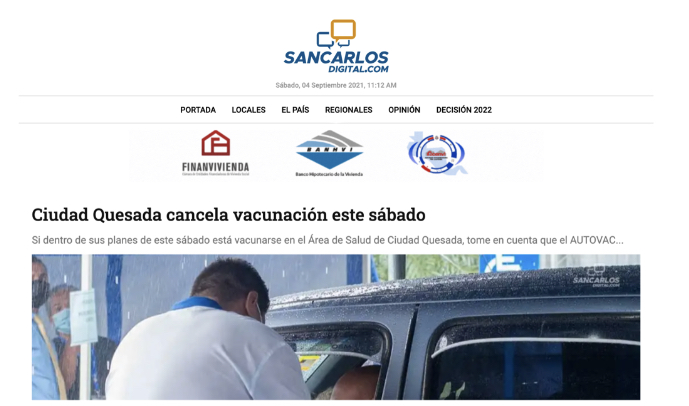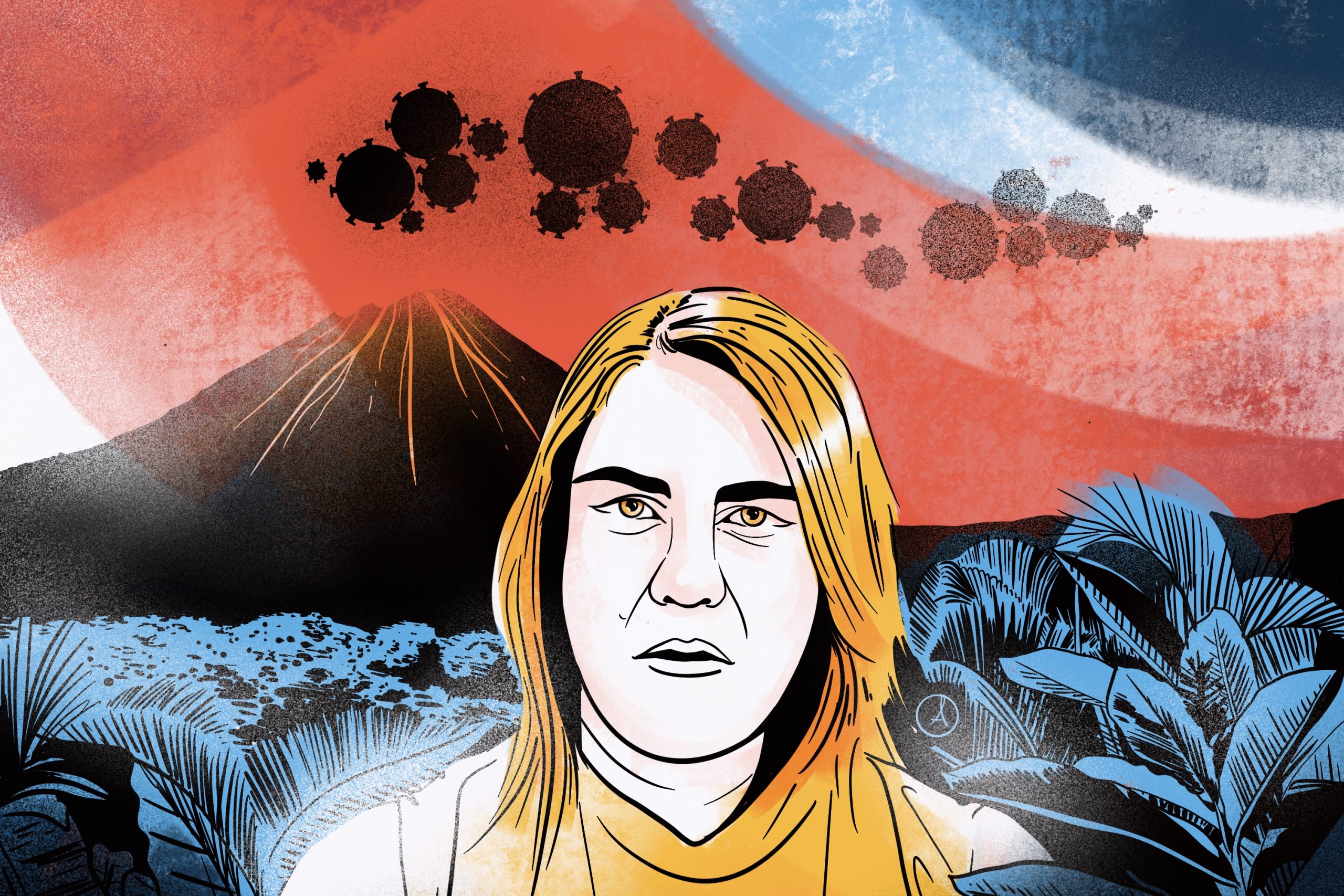Second in a four-part series on Costa Rica’s fight against fake news.
With an infodemic raging in Costa Rica as it is around the world—that is, false and misleading information about COVID-19 vaccines, and so many other topics, racing through social media feeds and WhatsApp chats—what’s the best way for the country’s media to react?
Surely it helps if a verification effort at a renowned national media organization grabs the piece of misinformation, researches it, and publishes a well-reasoned rebuttal? Especially if that rebuttal is circulated widely, where the misinformation is most prevalent?
Right?
Wrong. Or at least: it’s not that simple.
“I’ll be honest… you have to be very careful,” says Marcela Delgado, founder of San Carlos Digital, the leading regional news organization in Costa Rica’s Northern Zone, when she describes what it’s like to share verification pieces from the national La Nación’s #NoComaCuento verification project. “Oftentimes, [verification articles] have to do with the government.”
She has to avoid the appearance of alignment with the government at all costs, she says, to keep her readers’ trust, choosing to combat only the fake news items that have the most impact for her community.
Many rural areas “have been completely forgotten by governments that are Central Valley-focused,” says Stefano Cattani—who, at the nonprofit Demo Lab, works to promote civic dialogue and health of Costa Rica’s democracy, and with areas of focus including the coastal community of Nosara. He summarizes the attitude expressed by rural residents this way “‘They’re not paying attention to us, so why should we pay attention to them?’ This generates micro-societies where the communities themselves try to resolve problems on their own. We see it in Nosara, where the problem is so big… that the central government doesn’t even exist. The central government is fictitious.”
In a context like this, the word of a San José media organization like La Nación, which houses #NoComaCuento, or the University of Costa Rica, which houses Doble Check, can not only be ineffective in combating misinformation conveyed by much more trusted local actors—their word might actually do more harm than good. But local media often lack the resources for the rigorous and time-consuming work of verification journalism.
In such a context, what’s a journalist to do?
Building a bridge
Gustavo Arias knew it would be a tricky proposition. He also knew it was worth a try. After creating #NoComaCuento in 2017 to research and clarify misinformation and fake news, sharing the results through publications outside of La Nación’s subscription firewall, he lobbied for a way to link the initiative to local news organizations.
“I’ve always been a defender of the idea that we had to promote alliances with other media… although La Nación is skittish about that,” he says. Along with other Nación journalists, he requested funds from Google News Initiatives to ad multimedia to #NoComaCuento and also to build bridges with regional media. “My struggle was: if there’s a ‘Puntarenas Red News’ spreading false information, we need a ‘Puntarenas Blue News’ that’s doing it right. Outside of the GAM, the number one source of misinformation are Facebook groups or pages, because they work on the issues people care about. The problem is that these pages are being used—whether through malpractice, or intentionally,” to spread misinformation.
La Nación won the grant, and, in 2020, Gustavo began working with 13 of regional news organizations, chosen for their robust followings and willingness to hop aboard an effort to address fake news. The idea was that the project would build a two-way street: local media, who received a small stipend to cover their time dedicated to the project, would receive #NoComaCuento material that they could reproduce on their sites. At the same time, they would feed Gustavo the misinformation they were seeing in their communities but didn’t have time to research. That way, in theory, the resources of Costa Rica’s newspaper of record and its verification and data journalists could be put into creating a response.

“In broad strokes, what we did was recruit a series of regional media that were covering their communities’ events with seriousness,” says Sofía Chinchilla, who now runs #NoComaCuento following Gustavo’s exit from La Nación in February 2021. “With those media, we reached a legal agreement to work in alliance against disinformation.”
“We had a good response,” Gustavo says. “[Local] media were pretty excited to work on this… and they need economic resources.”
The COVID-19 pandemic, which more or less coincided with the launch of the regional outreach project, made these relationships more urgent, but it also sparked changes at La Nación that would affect the implementation of the project.
“We couldn’t hold the trainings we had planned,” Gustavo says. “And we were sent home, and we had our hours reduced.”
He says today that he is not sure how many #NoComaCuento stories were published by local media, or how many tips were actually received and acted on as a result of the alliance—but that simply opening the doors of communication was an enlightening process for him and his colleagues at La Nación.
“Sometimes we were blind to the things that were circulating outside of the GAM,” he says, adding that he sometimes had to remind the interns whose work stretched #NoComaCuento’s budget not to be judgmental about stories that came in from rural areas. “I always told the interns, ‘At #NoComaCuento, no issue can be cast aside… you might think it’s absurd, like they’re going to steal your children [a commonly shared fake news item in Costa Rica deals with a ring of child-stealing criminals], but we don’t know know how this is affecting people’s lives. A little more humility is needed.”
What was the process like from the other side?
Deep distrust
Marcela, of San Carlos Digital, was one of the participating media organizations. After years working in San José, including at national news channel Repretel, she returned to her home region in hopes that she’d be able to find a more relaxed work schedule and spend more time with her teenage daughter after years of returning to San Carlos only on weekends. She soon found herself launching a media organization all her own: the first digital native for the region. Sancarlosdigital.com now has more than 50,000 Facebook followers and a wide range of advertisers from all over the region.
Inherent to her mission, she says, is meeting readers wherever they are.
“Our target audience is different than in many areas. We have migratory flows; we have one of the highest poverty rates in the country, and illiteracy,” she says, adding that she produces content “so that la señora who reads us in Los Chiles can read it and understand it.”
She says that given the influence of misinformation in her region, the relationship she was able to build with La Nación was hugely helpful, and echoes Gustavo’s and Sofía’s comments that regional media organizations rarely have the resources to dive deep into misinformation stories.
However, she says the key for her was to pick and choose very carefully which #NoComaCuento stories she carried, focusing on the topic most urgent in her region—COVID-19—and also to make it very clear to her readers that they were a distinct brand and voice.

“Part of the strategy was that: for people to get to know the [#NoComaCuento] product without connecting us to it,” she says. “We started to filter the topics a little bit. Here, we have to fight against specific misinformation related to the pandemic, and unfortunately, one of the biggest sources of [bad] information in this country is this canton.”
She also echoes Gustavo’s comment about judgment coming from the Central Valley.
“On Twitter, everyone makes fun of San Carlos, but there’s something they’ve failed to understand. There are communities in San Carlos that are three or four hours away from Ciudad Quesada,” she says, referring to her region’s biggest town. “There’s no drinking water or school… how is someone there going to have access to information? What happens? Misinformation arrives. That señor has his little phone, and when he walks out 3 km [to get signal] and to see who has sent him a message, he sees pure fake news.”
One of the challenges facing local media organizations seeking to correct misinformation is the sheer amount of time involved in verifying information. Sofía explains that in order for #NoComaCuento to retain its reliability, it’s essential that she maintain the most rigorous possible standards, including total transparency about every piece of information she’s using. As Darío Chinchilla of Doble Check said in the August 29th episode of the Animales Políticos docuseries, “Right here, where we’re sitting right now, we could generate three pieces of fake news, but to generate the verification of that news, it could take a whole week.”
Marcela and her fellow local-news founder, Helen Naranjo of Los Santos Digital, don’t have that kind of time. Both journalists say that one of the most effective ways they’ve found to address local news with limited time and resources is to interview local authorities related to the piece of misinformation.
“When they put a piece of information in the [WhatsApp] chats, I write to the press officers,” says Helen, who, like Marcela, has a wide network of contacts in journalism and government thanks to her years as a journalist in San José. “Today they put something about the Caja, so I wrote the Caja’s communications chief and asked whether it was true. People write to me and say, ‘Helen, is this real? You’re a journalist—is this true?… Sometimes I feel like a Caja office.”
Marcela, who averages 12 articles a day, sometimes takes these verification chats live and on-air as the fastest way to get an impact.
“Another of the strategies has been that, the moment something comes out… an immediate interview. Now that we have so much ease with Facebook Live and all that, it’s almost an immediate reaction. We look for experts on the issue. If it’s a health issue, we look for the hospital director… ‘The bishop said we’re not supposed to get vaccinated? Let’s ask the bishop.’”
When we spoke on August 28th, she was fresh off a Facebook Live interview with Édgar Carrillo, director of the San Carlos Hospital. During the 21-minute chat, which has been viewed 1,400 times, she and Dr. Carrillo discussed some of the most frequent myths about the COVID-19 vaccine.

The result?
By the end of the call, “about 20 people who hadn’t gotten vaccinated were asking us where they could get vaccinated,” she says, recalling that her response to the hospital director was: “We’ve got 20 more people! Go and get out your car and pick them up so they can get vaccinated!”
Efforts on hold, with an election looming
At the time of this writing, with the infodemic still raging and a presidential and legislative election just months away, both #NoComaCuento’s regional media initiative, and Doble Check at the University of Costa Rica, are in a state of limbo.
The Google News Initiative funding for the regional news support ended in February 2021. Gustavo’s successor, Sofía Chinchilla, is assigned to #NoComaCuento only half-time; the rest of her time at La Nación is dedicated to the Data Unit. Without additional funding and support, she’s unable to maintain the regional news initiative.
Doble Check is currently on hold following founder Darío Chinchilla’s departure for Panama earlier this year for family reasons. He says the UCR public hiring process is still underway so that the project can continue, now under the auspices of Radios de la UCR.
Costa Rica’s local media are proliferating; they are on the front lines of the fight against misinformation; and, for the most part, they are on their own. At the same time, authentic news sites staffed by journalists doing original reporting compete with other sites or, in particular, Facebook pages and groups, that pose as local media but are actually aggregating or generating misinformation. And they’re doing it in an economic and media climate that generally require months or years of unpaid work before an organization can start to cover its costs.
Next week in “Infodemic”: Why is anyone still in the game? And how are they surviving?
During this month of September, we’re turning our attention at El Colectivo 506 to the health of our democracy, and how disinformation and fake news is causing new symptoms in our society. Join us for “Infodemic,” a month behind the scenes of Costa Rican news. View the complete edition here. We are pleased to be partnering with artist and graphic designer Allan Fonseca, who is creating the illustrations for “Infodemic,” including this week’s illustration of San Carlos Digital’s Marcela Delgado. Learn more about Allan here.





